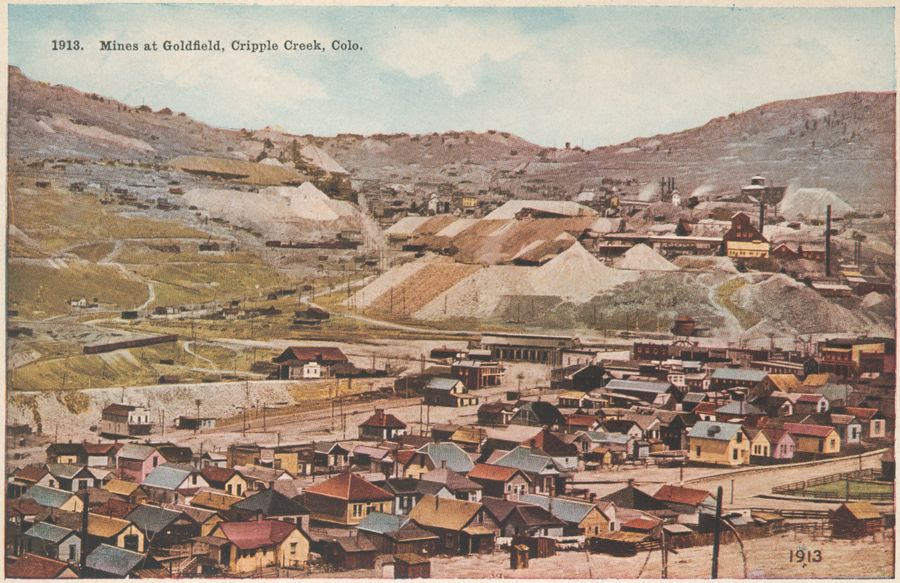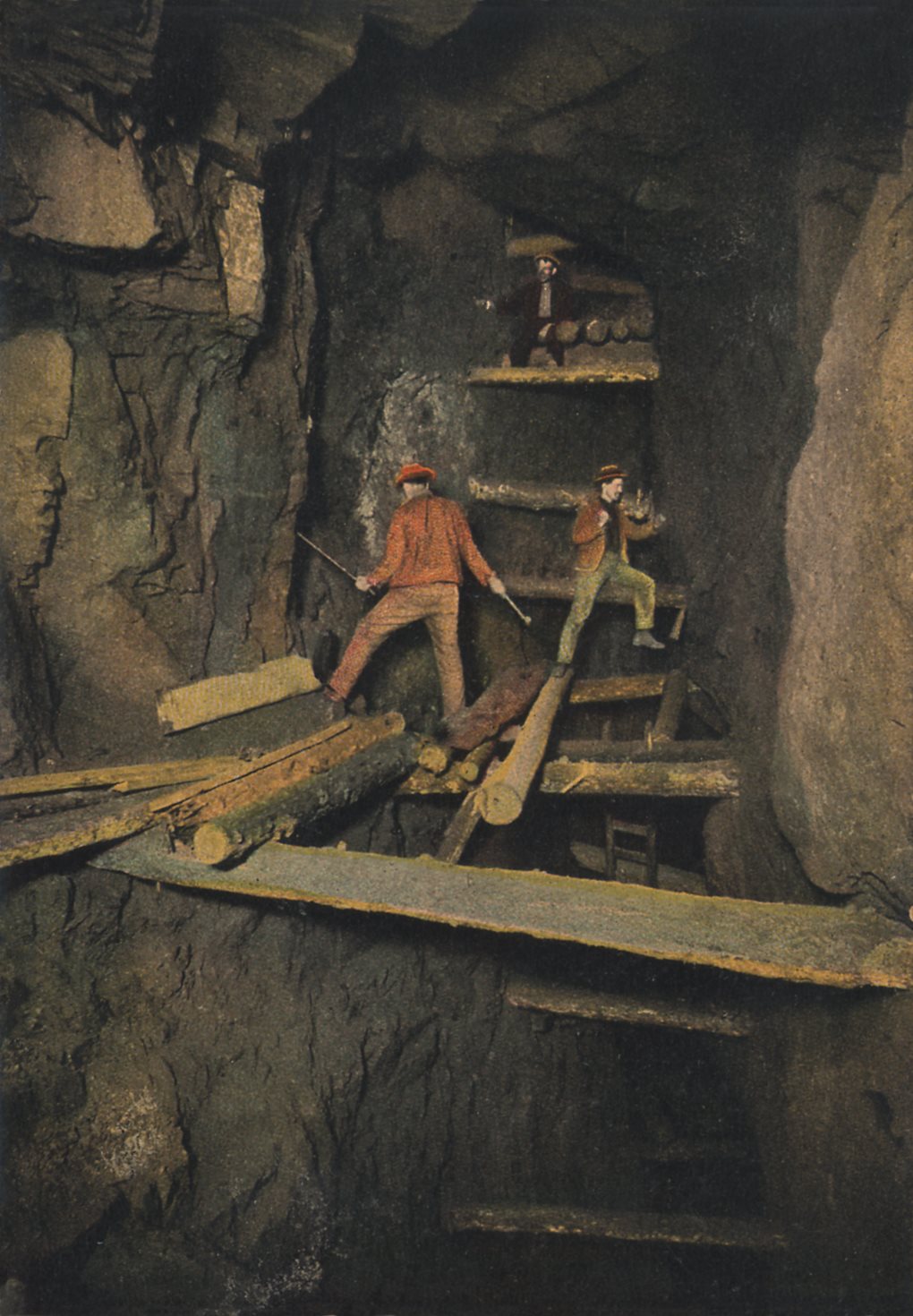-> HathiTrust Digital Library Site; Link to First Page.
Source had no pics, so I used pics from my collection
The latest results of the recent resurvey of Cripple Creek by the United States Geological Survey are now before us in full, and they meet with our hearty admiration, principally from the candor and fearlessness with which the writers have expressed what they believe to be the truth, the actual condition, the bottom facts and the probable future.
The report is neither optimistic nor pessimistic, but conscientious. There may be a class of men afraid of the truth, afraid to look facts fearlessly in the face, who may not like such a report on their camp and the pride of Colorado, but there are others equally proud of Cripple Creek's long standing reputation and equally hopeful of its future, who will welcome such a report.
That Cripple Creek has probably seen its best bonanza days but is still a good camp, is nothing more than the common experience of great mining camps the world over. Curie in his book of the "Gold Mines of the World" after his vast experience and with his well known and fearless candor emphasizes again and again that mines as a rule the world over do not grow richer, in depth but the contrary, and Van Hise and others from a purely scientific point of view have called attention to the first 1,000 feet of depth of a mining region being generally the best, rather than the second or third thousand.
From our experience we would confirm and reiterate these statements, and go further in stating that were we investors in mines we would take the first 500 feet of most mines, and then sell out. And that an old mine with a big past reputation is not nearly so likely an investment as a young mine with its reputation yet to make.
Among the results of the new survey, rock which from Mr. W. Cross determination we have been accustomed to call andesite and andesitic breccia, turn out to be phonolite and fragments of a porphyritic phonolite mingled with granitic debris. In fact all the varieties of eruptive rock have more or less a phonolltic origin, and all come from one original molten magma, the varieties observed resulting from differentiation.
The breccia occupies a steep-walled chasm in a typical volcanic neck. The deep crater was formed by a volcanic explosion in pre-Cambrian crystalline rocks forming the plateau. The breccia is cut by intrusive bodies principally of phonolite. There is no evidence of secondary enrichment; the tetrahedrite or gray copper supposed to be a secondary mineral is of primary origin.
When one ore shoot ceases in depth another may be found below it. There is no decrease in value of the ore per ton in depth, but the quantity of ore available is distinctly less below the 1,000-foot level and the ore-bearing fissures less in number and size.
Water and most of the substances contained in the veins were given off by intrusive bodies showing cooling at considerable depth and were forced up through the upper part of the volcanic mountain as soon as the formation of fissures allowed them to rise. The heated waters ascended through fissures and on nearing the surface spread through a large space in a complicated fissure system.
Speed was there checked and precipitation of ores took place, hence the richness and abundance of ore near the surface and its diminution in depth. The portion of the volcano now removed by erosion may have contained still richer deposits. It is probable that the production of the district, while exhibiting fluctuations, will, on the whole, slowly decline.
New ore bodies may be discovered from time to time, and individual mines may be as profitable in the future as they have been in the past. An increased output may follow each successful step in deep drainage. But existing conditions indicate that if the maximum production of $18,000,000 in 1900 is to be surpassed, the increase will come from ore bodies encountered in a zone within 1,000 feet of the present surface.
The drainage tunnels already made have proven an incalculable boon to the waterlogged mines, and still greater results will follow the gigantic drainage scheme now in contemplation.
The underground water is held within open fissures and stored in the rocks of the volcanic neck. It is stored water inclosed by the impervious rim of granitic rock surrounding the crater and has been supplied by the rain and snow that fell upon the surface of the district.
Some of the mines have revealed in depth the presence of noxious gases consisting of nitrogen and carbon dioxide with some oxygen. These are the last exhalations of the Cripple Creek volcano. None of the massive rocks were surface flows, but subterranean intrusions. Coaly material and carbonized trunks of trees have been found deep down in some of the workings; these are relics of trees growing in the surrounding region that fell into the crater after the explosion.
At the present time not more than ten of the really large mines are operated by their owners. Most of them are worked by lessees. Numerous small mines are in active operation. The cost of mining is high. The right kind of milling treatment has been solved by chlorination and cyaniding.
The greater part of the ore has come from the central area of breccia which is also the center of the volcanic eruption. The productive area is covered by the area of a circle 3½ miles in diameter. Few mines of importance lie outside of this area and the surrounding districts have not shown much promise.
Water till lately has been a source of much trouble.
The veins are mostly narrow and usually in sheeted zones of rock. Some vein systems do not reach the surface. Within the volcanic neck the fissures are most abundant and persistent in its southern half.
There is a radical arrangement both of the lode fissures and the dikes. The prevailing strike is northeast. The fissures and sheeted zones appear to have been formed by compressive stress due to the slipping back into the narrowing crater of the rock after it was ejected and consolidated.
Fissures are comparatively short in length on the surface and rarely exceed half a mile. Persistence of a fissure down the dip is proportioned to the length of the fissure. Many short fissures die out at moderate depth. In a few cases the fissures are nearly flat. Fissures intersect one another without displacement and faulting is very rare.
The fractures produced were under a light or moderate load. They are connected with the local volcanic center. The average value of the gold in the ores is now from $30 to $40 per ton. This all comes from the telluride ores, the pyrite is barren.
The ore occurs in shoots. Of the known ore bodies, as few exceed 1,000 feet in horizontal width, so very few exceed 1,000 feet in length, or extend more than 1,000 feet from the surface. Explorations below that limit have not proved very satisfactory. The upper 700 or 800 feet have yielded more than the interval from that limit to the lowest levels reached, or 1,500 feet.
A few mines have still good ore at 1,400 feet from the surface.
Underground water has deterred many from going below the 1,000-foot zone. The waters depositing the ore and filling the vein fissures were hot and alkaline. The ores were deposited at moderate depths, ranging from a few hundred feet below the surface, and the eroded and vanished cone of the ancient volcano to a maximum depth of 3,000 feet.
The occurrence of carbonized tree trunks in the breccia tends to confirm this shallow origin conclusion. The ores were formed later than the latest eruption of basic dikes. The ore-depositing water was derived from magmas under diminishing pressure. Also perhaps in part from atmospheric waters.
*1 U. S. Geological Survey, 1906; Profesional Paper No. 54. Geology and Gold Deposits of Cripple Creek District by F.L. Ransome and Waldemar Lindgren.

